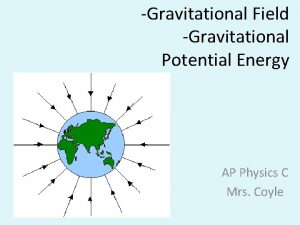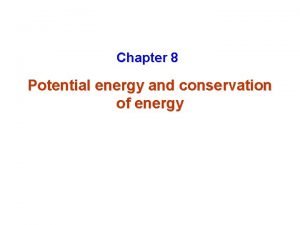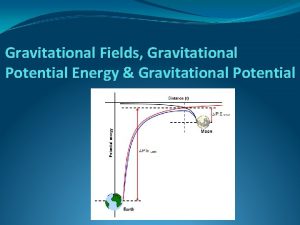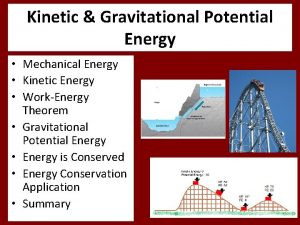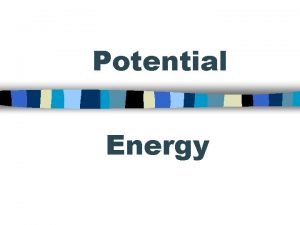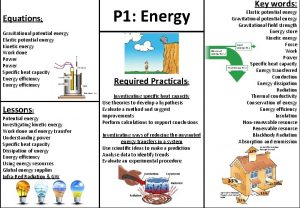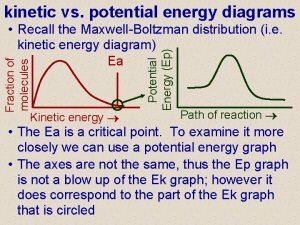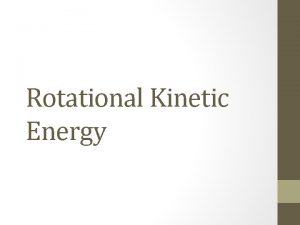GRAVITATIONAL AND POTENTIAL ENERGY AND KINETIC ENERGY Lesson















- Slides: 15

GRAVITATIONAL AND POTENTIAL ENERGY, AND KINETIC ENERGY Lesson 2

GRAVITATIONAL POTENTIAL ENERGY (EG) The type of energy that an object possess because of its position above some level. The energy is called potential because it can be stored and used at a lower level for work. When an object falls, its potential energy is transformed into kinetic energy as its speed increases.

KINETIC ENERGY ( EK) Energy due to the motion of an object

GRAVITATIONAL POTENTIAL ENERGY Since the force (F) required to lift an object without accelerating is the same as the objects weight (mg), the energy (Eg) required to lift an object is the same as its potential energy from the height it was lifted from. Since F = mg, we can make a common equation for gravitational potential energy. Eg = F∆h = mg∆h, where g = 9. 8 N/kg Energy is measured in joules and height is measured in meters.

The potential energy in a system must be based against a Reference Level – The level to which the object may fall. It is important to note that when answering questions about relative potential energy, it is important to state the reference level.

EXAMPLE 1 In the sport of pole vaulting, the jumper’s point of mass centralization, called the centre of mass, must clear the pole. Assume that a 59 kg jumper must raise the centre of mass 1. 1 m off the ground to 4. 6 m off the ground. What is the jumper’s gravitational potential energy at the top of the bar relative to the point at which the jumper started the jump? h = 4. 6 – 1. 1 = 3. 5 m m = 59 kg g = 9. 8 N/kg Eg = ?

Eg = mgh Eg = (59 kg) (9. 8 N/kg) (3. 5 m) Eg = 2. 0 x 103 J Therefore, the jumpers gravitational energy relative to the lower position is 2. 0 x 103 J

KINETIC ENERGY Objects energy depends on two factors: 1. Mass 2. Speed The kinetic energy increases in direct proportion to the mass, and it increases in proportion to the square of the speed.

Where EK is the kinetic energy measured in joules (J) m is the mass in kilograms (kg) v is the speed in metres per second (m/s)

EXAMPLE 2 Find the kinetic energy of a 6. 0 kg bowling ball rolling at 5. 0 m/s m = 6. 0 kg v = 5. 0 m/s Ek = ? EK = 75 J Therefore, the kinetic energy of the bowling ball is 75 J.

MECHANICAL ENERGY The sum of gravitational potential energy and kinetic energy is called mechanical energy. Emechanical = EK + Eg

When an object is raised to a position above a reference level, it contains the same amount of energy as it will at any point in the fall; the energy will just be in a different form. Ek = E g

QUESTIONS A o. 45 kg book resting on a desktop 0. 64 m high. Calculate the book’s gravitational energy relative to A) the desktop and B) the floor. T (2) ) The elevation at the base of a ski hill is 350 m above sea level. A ski lift raises a skier (total mass 72 kg) to the top of the hill, now the if the skiers gravitational potential energy relative to the base of the hill is 9. 2 x 105 J, what is the elevation at the top of the hill? T (1)

Calculate the kinetic energy in each of the following; � During a shot put, a 7. 2 kg shot leaves the athletes hand at a speed of 12 m/s T (1) � A 140 kg ostrich is running at 14 m/s T (1) A softball traveling at 34 m/s has a kinetic energy of 98 J. Calculate its mass. T(1)

A 1. 0 kg object accelerates from a speed of 0. 0 m/s to a speed of 5. 0 m/s � Determine the object’s kinetic energy at each of these speeds: 0. 0 m/s, 1. 0 m/s, 2. 0 m/s, 3. 0 m/s, and 4. 0 m/s T (2) � Draw a graph of the kinetic energy (vertical axis) as a function of speed. C (1) � By what factor does the kinetic energy increase when the speed increases from 1. 0 to 4. 0 m/s? T (1) � By what factor does the kinetic energy increase when the speed increases from 1. 0 to 5. 0 m/s? T (1)
 Gravitational kinetic energy equation
Gravitational kinetic energy equation Gravitational potential energy vs kinetic energy
Gravitational potential energy vs kinetic energy Lesson 2 kinetic and potential energy answer key
Lesson 2 kinetic and potential energy answer key Kinetic energy examples
Kinetic energy examples The change in mechanical energy
The change in mechanical energy Kinetic energy and potential energy formula
Kinetic energy and potential energy formula Potential energy units
Potential energy units Potential vs kinetic energy
Potential vs kinetic energy Gravitational potential energy equation
Gravitational potential energy equation Gravitional energy
Gravitional energy Gravitational potential energy
Gravitational potential energy Expression for gravitational potential energy
Expression for gravitational potential energy Gravitational potential energy
Gravitational potential energy Forms of energy
Forms of energy Gpe =mgh
Gpe =mgh Thermal energy formula
Thermal energy formula










